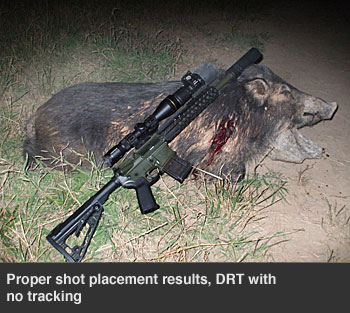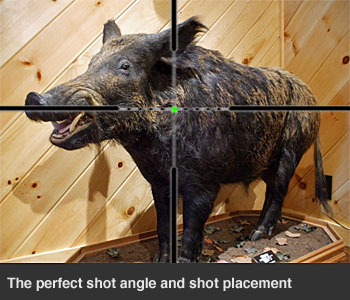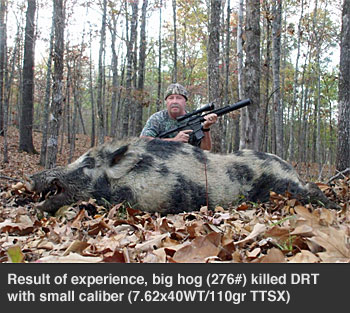
Having now shot over 1000 hogs with calibers ranging from .223 to 9.3×62, I feel I’ve learned a little about shot placement and what hogs do after being shot. I’ll share with you my observations based on years of real world hog hunting. Caliber, bullet, shot placement, your range to target, the size of your target – all these factor into killing and recovering your hog.
Shot Placement
Let’s start by looking at shot placement. Some will say that shot placement is the only important factor. While there is an element of truth to that, we’re not talking about shooting a stationary target in a laboratory setting. Shot placement is critical, so it’s a good place to start this conversation. Here are my observations based on years of real world hog hunting:
Brain shot
This is a VERY risky shot, since the target is small and almost always moving.
RESULTS – Dead Right There (DRT) animal every time. You won’t have to follow a blood trail to find these.
CALIBER SELECTION – Take your pick. A .223 is just as deadly as a .458 SOCOM.
Spine shot
The spine shot is my personal preference when hog hunting.
RESULTS – DRT animal every time, if the spine is damaged sufficiently.
CALIBER SELECTION – Any caliber that will penetrate to the center of the animal will do the job. I have not observed any difference in results with a 6.8 SPC or a .458 SOCOM, dead is dead!
Heart/lung shot:
 RESULTS – Animal will run off the majority of the time, often without showing ANY sign of being hit. Sometimes there is a blood trail (usually starting at least 20 yards from where the animal was shot). Sometimes there is no blood trail. The dead animal is usually found 25-75 yards from where it was shot.
RESULTS – Animal will run off the majority of the time, often without showing ANY sign of being hit. Sometimes there is a blood trail (usually starting at least 20 yards from where the animal was shot). Sometimes there is no blood trail. The dead animal is usually found 25-75 yards from where it was shot.
I estimate that more hogs are killed than recovered. Hunters often assume they have missed, or poorly placed the shot, when they don’t find a blood trail starting at the point where the hog was when they shot it. I frequently see clients go up to where they shot the hog looking for, and expecting to see, blood. I don’t bother. I go to where I saw the hog enter the thick stuff and start there.
As a side note, wounded hogs will almost always follow an established trail. If you don’t have a blood trail, follow these established trails out 100yds until you find the hog or give up. If you haven’t found the hog within 100 yards from where you shot it, you probably won’t.
CALIBER SELECTION – Size does matter here. The bigger or faster bullet you hit them with, the better the chance of a blood trail, the greater the chance of finding them closer to where you shot them. Calibers of 300 WM and larger definitely put them down quicker. However ANY caliber that gets the bullet into the lungs/heart will result in a kill.
Poorly placed shot:
Nobody plans a poorly placed shot, but it happens. Sometimes it’s because shooting a moving target is a bit trickier. A distraction could play in. Lack of experience or too much coffee could play roles here.
RESULTS – Animal rarely found unless shot out in the open.
CALIBER SELECTION – Now SIZE REALLY matters! Using a .308 or larger caliber definitely increases your odds of animal recovery. I have found animals shot with a .458 SOCOM that I would have never found had they been shot with a small caliber.
A few tips to increase your chances of a successful hunt:
1. Always get as close to the animal as possible. Not only is it fun with it’s own challenge, it mitigates other factors. My average shot distance is between 60 and 80 yards.
2. Use a shooting rest if at all possible, I carry a Stoney Point Expedition bi-pod with me on every hunt, and use it for 99% of my shots. It works great for kneeling or standing shots.
3. Be patient and wait for the perfect shot opportunity. If the hog/hogs are feeding, the wind is in your favor, you’re quiet and you move slowly, you can normally get closer than 100 yards. You should have plenty of time to pick your shot. A little patience here can save you a lot of time and/or disappointment later. Think about that next time you see a wild hog in your sites.
4. Use proper optics. I consider a good quality (no blister pack scopes here) 3-9×40 scope a minimum for hog hunting since low light is often involved. At this point in time, mid-year 2012, I think the Leupold VX-R 3-9×50 is the best value in a GOOD hog hunting riflescope. A hog looks like a big target and it is, but shot placement for KILLING a hog is PRECISION shooting. I want all the light gathering I can get, a minimum of 6x magnification and an illuminated reticle.
Bottom line:
 It’s all about shot placement and bullet selection.
It’s all about shot placement and bullet selection.
The perfect shot has the animal slightly quartering to you. Place the shot vertical center of mass where the neck meets the front of the shoulder. This will almost always sever the spine and penetrate into the lungs, putting both plan A and plan B in play. This shot will usually result in a DRT animal. If not, the animal will usually be dead within 25-75 yards..
That perfect shot still needs the right bullet. You MUST use a tough bullet, one that will penetrate. I always want to see an exit wound.
Matching the right bullet to the right caliber isn’t a simple math formula. The more experienced the hunter, the lighter caliber one can use successfully. I have inexperienced hunters/clients wound hogs all the time under conditions that would have been easy for me or any other experienced hunter. Conditions and shooter skills really have to be taken into consideration here.
- Experienced hunter = Smaller caliber
- Less experience = Bigger caliber
- Hog in the open = Smaller caliber
- Hog in or next to the really nasty tick stuff = Bigger caliber
- Hunting at night = Bigger caliber
- BIG tough hog = Bigger caliber
When things go right almost any caliber will work, when things go wrong even the biggest caliber may not get the job done. Bigger is always better if you’ve botched the shot.
Personally I consider a 260 Rem/6.8 SPC class of cartridge, shooting a tough bullet, the minimum for overall successful hog hunting. Cartridges in the.308 class and larger substantially increase your odds over time of animal recovery. If you must shoot a 5.56/.223 for hog hunting – if you ask me – the ONLY bullets are the Barnes 62gr or 70gr TSX!
When it comes to the question of how to kill and recover a hog, tactical hog hunting or otherwise, now you know the key pieces of the puzzle. It’s fun to try out different guns, gear and calibers. If you don’t have the time or interest in investing in trying out lots of options, keep up with SHWAT.com where you’ll continually find great resources. Take that knowledge and experience and stack the deck in your favor to maximize your opportunities to bring home the bacon next time you’re hunting.
 What are my favorite hog hunting calibers?
What are my favorite hog hunting calibers?
As most of you know I’m a “gun guy” so I like to play with lots of different guns and calibers. But here are my favorite calibers and bullets that I enjoy and have really worked for me under a variety of conditions.
6.8 SPC, Barnes 110gr TSX
7.62x40WT, Barnes 110gr TTSX LV
.30 Rem AR, Nosler 150gr Accubond
.308, Barnes 150gr TTSX
.30-06, Barnes 165gr TTSX
.358, Nosler 225gr Partition
.458 SOCOM, Barnes 300gr TAC TX


Thank you for sharing your knowledge.
This is great information. I really appreciate all the time you put into this post. I’ve been trying to find the most effective way to hunt these beasts. Haha they’re a pretty stinking tricky to put down!
Very helpful..
Thank you